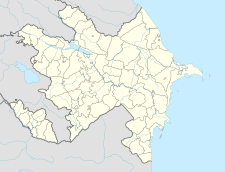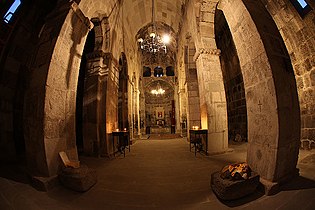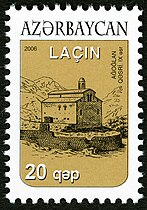| Revision as of 15:32, 16 February 2021 editInternetArchiveBot (talk | contribs)Bots, Pending changes reviewers5,388,187 edits Rescuing 1 sources and tagging 0 as dead.) #IABot (v2.0.8) (Nintendofan885 - 7172← Previous edit | Revision as of 03:21, 19 February 2021 edit undoTherealll333 (talk | contribs)28 editsm Undid revision 1007119643 by InternetArchiveBot (talk)Tags: Reverted references removedNext edit → | ||
| Line 56: | Line 56: | ||
| | designated = | | designated = | ||
| }} | }} | ||
| '''Tsitsernavank'''{{efn|Alternatively spelled '''Tsitsernavank''' or '''Dzidzernavank'''}} ({{lang-hy|Ծիծեռնավանք}}, {{lang-az|Sisərnəvəng}} or {{lang|az|Ağoğlan}}) is a fifth-to-sixth century<ref name="IoAA"/><ref>Turner, Jane (ed.). ''The Dictionary of Art''. New York: Oxford University Press, USA, 2003, p. 425. {{ISBN|0-19-517068-7}}.</ref> ]<ref>Paolo Cuneo, "La basilique de Tsitsernavank dans le Karabagh," '']'' 4 (1967), pp. 203—216</ref><ref>Tom Sinclair. Architecture:Armenian Monasteries // Encyclopedia of Monasticism / Associate Editors John W. Barker Gail Geiger Richard Lansing. — ], 2013. — P. 54</ref><ref name="IoAA"/> and former monastery in the ] of ]. The monastery is within five kilometers of the border of ]'s province of ]. | '''Tsitsernavank'''{{efn|Alternatively spelled '''Tsitsernavank''' or '''Dzidzernavank'''}} ({{lang-hy|Ծիծեռնավանք}}, {{lang-az|Sisərnəvəng}} or {{lang|az|Ağoğlan}}) is a fifth-to-sixth century<ref name="IoAA"/><ref>Turner, Jane (ed.). ''The Dictionary of Art''. New York: Oxford University Press, USA, 2003, p. 425. {{ISBN|0-19-517068-7}}.</ref> ]<ref>Paolo Cuneo, "La basilique de Tsitsernavank dans le Karabagh," '']'' 4 (1967), pp. 203—216</ref><ref>Tom Sinclair. Architecture:Armenian Monasteries // Encyclopedia of Monasticism / Associate Editors John W. Barker Gail Geiger Richard Lansing. — ], 2013. — P. 54</ref><ref name="IoAA"/> and former monastery in the ]. The monastery is within five kilometers of the border of ]'s province of ]. | ||
| == Etymology == | == Etymology == | ||
| There are two interpretations about the ] etymology of the church. The first interpretation is that the name of the church is based on Armenian word "]", which means ]. According to researchers, the usage of this name of because of swallows who made nests in the church's ruins.<ref name="IoAA" /> According to the other interpretation, the name of the church is based on Armenian word "]", which means ], presumably a reference to the relics of St. George that were kept in the church<ref>{{cite book |chapter=Tzitzernavank |title=Documents of Armenian Architecture/Documenti di Architettura Armena Series |publisher=Polytechnique and the ] |volume=vol. 21 Milan |edition=OEMME Edizioni |year=1989 }}</ref> | There are two interpretations about the ] etymology of the church. The first interpretation is that the name of the church is based on Armenian word "]", which means ]. According to researchers, the usage of this name of because of swallows who made nests in the church's ruins.<ref name="IoAA" /> According to the other interpretation, the name of the church is based on Armenian word "]", which means ], presumably a reference to the relics of St. George that were kept in the church<ref>{{cite book |chapter=Tzitzernavank |title=Documents of Armenian Architecture/Documenti di Architettura Armena Series |publisher=Polytechnique and the ] |volume=vol. 21 Milan |edition=OEMME Edizioni |year=1989 }}</ref> | ||
| The etymology of the ] name for the church, ''{{lang|az|Ağoğlan}}'' (''Aghoghlan''), is believed to be related to the river passing nearby, which possesses the same name.<ref>{{cite book |title=Зодчество Кавказской Албании |last=Mammadova |first=Gulchohra |author-link=Gulchohra Mammadova |year=2004 |publisher=Chashyoglu |location=Baku |language=ru }}</ref> | |||
| ==History== | ==History== | ||
| Line 84: | Line 82: | ||
| ==Gallery== | ==Gallery== | ||
| <gallery mode="packed" heights="140"> | <gallery mode="packed" heights="140"> | ||
| File: |
File:Tsitsernavank-Monastery.jpg| Southern wall of the monastery | ||
| File:Cicernavank1.jpeg|Tombstone with Armenian inscripions close to church | File:Cicernavank1.jpeg|Tombstone with Armenian inscripions close to church | ||
| File:Ağoğlan.JPG|Plan of the basilica | File:Ağoğlan.JPG|Plan of the basilica | ||
| File:Tzitzernavank Monastery 100.JPG|Outer wall surrounding the monastery | File:Tzitzernavank Monastery 100.JPG|Outer wall surrounding the monastery | ||
| File:Cicernavank3.jpeg|The Monastery's interior. | File:Cicernavank3.jpeg|The Monastery's interior. | ||
| File: |
File:Tsitsernavank Monastery 113.JPG | ||
| File:Stamps of Azerbaijan, 2006-725.jpg|Azerbaijani stamp depicting the monastery | File:Stamps of Azerbaijan, 2006-725.jpg|Azerbaijani stamp depicting the monastery | ||
| </gallery> | </gallery> | ||
| Line 107: | Line 105: | ||
| ==External links== | ==External links== | ||
| * | * | ||
| * |
* , ], ARCHITETTURA ARMENA - Catalogo della MOSTRA DI ARCHITETTURA ARMENA tenuta a Bergamo, presso il Palazzo della Ragione, 1975 - Torino | ||
| * | * | ||
| * | * | ||
Revision as of 03:21, 19 February 2021
| Tsitsernavank Monastery | |
|---|---|
 The monastery in 2015 The monastery in 2015 | |
| Religion | |
| Affiliation | Armenian Apostolic Church |
| Location | |
| Location | Hüsülü/Ağoğlan, Lachin District, Azerbaijan |
 | |
| Geographic coordinates | 39°38′38″N 46°24′31″E / 39.644°N 46.408511°E / 39.644; 46.408511 |
| Architecture | |
| Type | Three-aisled basilica |
| Style | Armenian |
| Completed | 5th-6th century |
Tsitsernavank (Template:Lang-hy, Template:Lang-az or Ağoğlan) is a fifth-to-sixth century Armenian church and former monastery in the Lachin District. The monastery is within five kilometers of the border of Armenia's province of Syunik.
Etymology
There are two interpretations about the Armenian etymology of the church. The first interpretation is that the name of the church is based on Armenian word "Tsitsernak", which means swallow. According to researchers, the usage of this name of because of swallows who made nests in the church's ruins. According to the other interpretation, the name of the church is based on Armenian word "Tsitsern", which means pinky finger, presumably a reference to the relics of St. George that were kept in the church
History

Historically, Tsitsernavank Monastery is located in Aghahechk, one of the 12 cantons of the historical Armenian province and principality of Syunik. By the 15th century Aghahechk had split into two districts: the northern half was called Khozhoraberd; the southern half, containing Tsitsernavank, was called Kashatagh.
The basilica of Tsitsernavank was believed to contain relics of St. George the Dragon-Slayer. In the past, the monastery belonged to the Tatev diocese and is mentioned as a notable religious centre by the 13th-century historian Stepanos Orbelian and Bishop Tovma Vanandetsi (1655).
In 1613, the monastery's fortified wall was repaired and its arched gateway was constructed. The building inscription in Armenian recording this act disappeared between 1989 and 1992, during the First Nagorno-Karabakh War. The church and its belltower were renovated in 1779. The building inscription in Armenian recording this renovation disappeared in 1967.
In the 19th century, it served as the parish church for the adjoining peasant settlement of Zeyva and was called St. Stephanos. Zeyva's Armenian inhabitants fled during 1905 Armenian-Tatar war, never to return. During the Soviet period, the village was renamed Gusulu and the church was unused but preserved as a historical monument. Tsitsernavank's church of St. George (St. Gevorg) was reconsecrated in October 2001, after a heavy restoration in 1999-2000 paid for by Armenian diaspora funds, and is a venue for annual festivals honouring St. George.
The church and the Lachin District were returned to Azerbaijan on 1 December 2020 as part of the 2020 Nagorno-Karabakh ceasefire agreement.
Architecture
The church has no early building inscriptions; however, based on its appearance, it is believed to have been constructed in three main stages. Its earliest form appears to have been a simple rectangular basilica, without an apse. Based on the style of the doorways in its south wall, this building period has been dated to the 5th or 6th century AD. However, an alternative thesis exists that dates this stage to the 3rd century AD, and suggests that it was a pre-Christian temple. During the second stage of construction, a windowless apse was added (constructed inside the eastern end of the rectangular interior) and the upper parts of the outside walls were built. This may have happened in the 6th century. At this period, the arcades that separated the interior nave from its aisles were probably still constructed of timber. In the third period of construction, stone pillars and arches replaced them. Based on the style of their capitals, this occurred sometime between the end of the 6th century and the beginning of the 10th century.
The monastery is recognized as a native Armenian example of an "oriental" basilica. Being a three-nave basilica, like most of those in Armenia of 5-6th centuries; Tsitsernavank's central nave is only slightly taller than the lateral naves, from which it is separated by two rows of pillars. The plan is similar to a series of Armenian basilicas like Yereruyk, Yeghvard, Dvin, Ashtarak (Tsiranavor), Tekor - in that it had an interior composed of three aisles or naves, the central and largest one of which was separated from the others by pillars which also helped support the roof.
The church has an inscription dating back before the 10th century that reads “Remember the prayers of your servant, the undeserving Grigor, for his beloved brother Azat.”
Gallery
- Southern wall of the monastery Southern wall of the monastery
-
 Tombstone with Armenian inscripions close to church
Tombstone with Armenian inscripions close to church
-
Plan of the basilica
-
Outer wall surrounding the monastery
-
 The Monastery's interior.
The Monastery's interior.
- File:Tsitsernavank Monastery 113.JPG
-
 Azerbaijani stamp depicting the monastery
Azerbaijani stamp depicting the monastery
See also
References
- Alternatively spelled Tsitsernavank or Dzidzernavank
- ^ Kouymjian, Dickran. "Index of Armenian Art: Armenian Architecture - Tsitsernavank". Armenian Studies Program. California State University, Fresno. Archived from the original on 2013-09-28.
- Turner, Jane (ed.). The Dictionary of Art. New York: Oxford University Press, USA, 2003, p. 425. ISBN 0-19-517068-7.
- Paolo Cuneo, "La basilique de Tsitsernavank dans le Karabagh," Revue des Études Arméniennes 4 (1967), pp. 203—216
- Tom Sinclair. Architecture:Armenian Monasteries // Encyclopedia of Monasticism / Associate Editors John W. Barker Gail Geiger Richard Lansing. — Routledge, 2013. — P. 54
- "Tzitzernavank". Documents of Armenian Architecture/Documenti di Architettura Armena Series. Vol. vol. 21 Milan (OEMME Edizioni ed.). Polytechnique and the Armenian National Academy of Sciences. 1989.
{{cite book}}:|volume=has extra text (help) - Hewsen, Robert H. (2001). Armenia: A Historical Atlas. Chicago: University of Chicago Press. pp. 100–104, 121–123. ISBN 0-226-33228-4.
- Karapetian, Samvel. Armenian Cultural Monuments in the Region of Karabagh. Yerevan: Gitutiun Publishing House, 2001, p. 145.
- Hasratyan, Murad M. Tsitsernavank. Yerevan: Vneshtorgizdat, 1990, p. 5.
- Karapetian. Armenian Cultural Monuments, p. 137.
- (in Russian) В Цицернаванке праздновали день Святого Георгия Победоносца, Kavkaz.Memo.Ru, 29/9/2003.
- https://www.rferl.org/a/churches-and-christian-monuments-due-to-be-handed-over-in-armenia-azerbaijan-peace-deal-/30944878.html
- Donabedian, Patrick and Jean-Michel Thierry, Armenian Art. New York: H.N. Abrams in association with Prelacy of the Armenian Apostolic Church of America-Catholicosate of Cilicia, 1989, p. 509.
- Hasratyan. Tsitsernavank, pp. 5-6.
- Donabedian and Thierry. Armenian Art, p. 509.
- Thais.it - Architettura Armena
- Orthodox encyclopedia, ed. by the Patriarch of Moscow and all Russia Alexius II, article "Armenia"
- Kouymjian, Dickran. "In Search of the History of the Ererouk Basilica". Armenian Studies Program. California State University, Fresno. Archived from the original on July 25, 2008. Retrieved May 11, 2008.
- https://theconversation.com/armenians-displaced-from-nagorno-karabakh-fear-their-medieval-churches-will-be-destroyed-149141
External links
- Some photographs of Tsitsernavank at RAA official site
- Dzidzernavank, Adriano Alpago Novello, ARCHITETTURA ARMENA - Catalogo della MOSTRA DI ARCHITETTURA ARMENA tenuta a Bergamo, presso il Palazzo della Ragione, 1975 - Torino
- 1700 years of Christian Armenia / Tsitsernavank (in Russian)
- A Brief History of the Art and Architecture of Artsakh — Nagorno Karabakh, by P. Donabedian, Dr. L. Durnovo, Dr. A. Yakobson, Dr. B. Ulubabian, S. Karapetian and B. Baratov
- 3D Model of The Monastery
- Armenian Apostolic churches
- Armenian Apostolic monasteries
- Christian monasteries in the Republic of Artsakh
- Christian monasteries in Azerbaijan
- Churches in Azerbaijan
- Armenian Apostolic monasteries in Azerbaijan
- Oriental Orthodox congregations established in the 5th century
- Christian monasteries established in the 5th century



